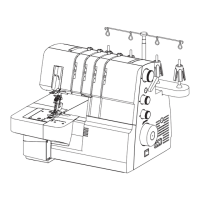24
* The Cover stitch can be used for covering, binding
or top-stitching necklines and for hemming the
bottom of T-shirts and sweat suits, etc. in addition
to flat joining seams (plain seaming). The Cover
stitch is most suitable for stretchy fabrics. It can
also be used for woven fabrics.
* Install needles C, D and/or E depending on
Cover stitch.
* The graduations on the cutter cover B indicate the
distance, from Cover stitch middle needle. Use it
as a guide when positioning the fabric edge.
* Close looper cover.
Chaining off is not possible after sewing Cover
because it causes the seam to unravel when
looper thread is pulled out at the end of sewing.
Therefore, secure the seam end in the following
manner.
When Sewing through to the Edge of Fabric
* Knot the needle threads (2 or 3 threads) together
first, as shown on the illustration.
* Tie these threads with the looper threads.
* Cut extra threads.
When Sewing is Stopped Halfway
* Pull out the needle threads (2 or 3 threads) on the
underside of the fabric and knot the threads in the
same manner as described above.
* Cut extra threads.
Note : Normally, the seams at the start of sewing do
not unravel, but it is wise to secure the seam
end following the same steps as described
when sewing through to the edge of the
fabric.
(1) MACHINE SET UP
(2) SECURING THE COVER STITCH SEAM
END
desired
stitch
the
18. COVER STITCH SEWING

